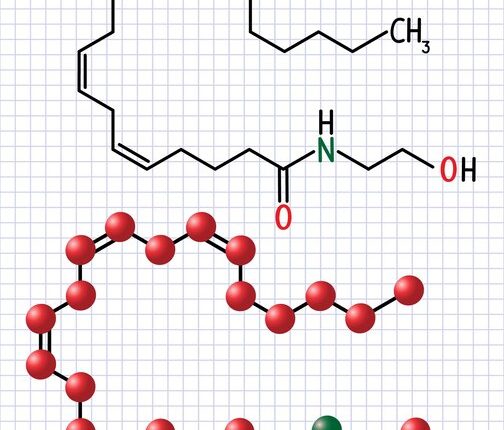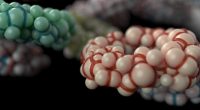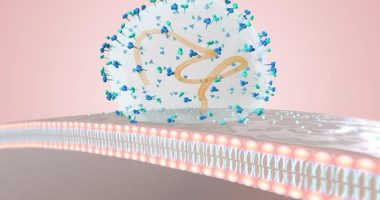In an exciting development in oncological pharmacology, researchers have focused on the potential of pyrrolidinedione-thiazolidinone hybrids as a new class of compounds for combatting human breast carcinoma. Despite the diverse genotypes of breast cancer cells, not all treatment options are universally effective due to the unique genetic and phenotypic profiles of varying tumor cells. This study, led by a team of multidisciplinary researchers including Nataliya Finiuk, Yuliia Kozak, and Agnieszka Gornowicz among others, investigates the proapoptotic effects of these hybrids with a primary aim to discern their efficacy across different breast cancer cell lines including MDA-MB-231, MCF-7, T-47D, and HCC1954, as well as in murine breast cancer model 4T1.
Utilizing a comprehensive suite of methodologies such as MTT, clonogenic, and [H]-Thymidine incorporation assays, along with more specialized approaches like flow cytometry, ELISA, and qPCR, the study delivers insightful findings on the selective toxicity of pyrrolidinedione-thiazolidinone hybrids. Remarkably, these compounds demonstrated significant toxicity towards tumor cells while exhibiting minimal adverse effects on pseudonormal breast epithelial cells, MCF-10A. The research underscores not only the therapeutic potential of these hybrid molecules irrespective of cancer cell genotype but also their capability to inhibit key processes involved in tumor survival and metastasis, such as DNA synthesis and protein involved in cancer invasiveness. This paper delves into these findings, offering a fresh perspective on tailored cancer therapeutics that could lead to more effective, precision-based treatment strategies for breast carcinoma.
This groundbreaking research into pyrrolidinedione-thiazolidinone hybrids represents a significant stride in the ongoing battle against breast cancer, a disease that remains one of the leading causes of cancer-related mortality among women globally. Traditional treatments such as chemotherapy, hormone therapy, and radiation, though effective for many, do not universally address the diverse genetic landscapes of breast cancer cells. The emergence of targeted therapy has ushered in a new era of precision medicine, yet the need for more adaptable and comprehensive treatments remains pressing. In this context, the study of pyrrolidinedione-thiazolidinone hybrids emerges as a promising avenue, potentially offering a more effective solution tailored to the unique demands of individual cancer profiles.
Breast cancer is characterized not only by its prevalence but also by its heterogeneity, displaying a broad range of genetic, molecular, and phenotypic variations. This diversity among cancer cell genotypes complicates the development of universal therapies. Current research indicates that there is no one-size-fits-all treatment, underscoring the necessity for innovative approaches that can adapt to this variability. Pyrrolidinedione-thiazolidinone hybrids, with their novel mechanism of action, represent a compelling development in this regard. By specifically targeting and disrupting crucial cellular processes essential for cancer cell survival and proliferation, these hybrids hold the potential to overcome the limitations posed by the heterogeneous nature of breast tumor cells.
The therapeutic efficacy of pyrrolidinedione-thiazolidinone hybrids was meticulously evaluated in various breast cancer cell lines, such as MDA-MB-231, MCF-7, T-47D, and HCC1954, covering a representative spectrum of the genetic diversity found in breast cancer. The inclusion of the murine breast cancer model 4T1 further substantiates the relevance of the findings, ensuring that the observed effects in vitro hold potential for translation into therapeutic modalities in vivo. The capability of these hybrids to exhibit selective cytotoxicity—harming cancer cells while sparing normal ones—aligns closely with the goals of precision medicine, which aims to maximize therapeutic efficacy while minimizing collateral damage to healthy tissues.
By deploying a robust array of methodologies, the research not only demonstrates the biological activity of pyrrolidinedione-thiazolidinone hybrids but also elucidates the pathways through which they exert their effects. The selective inhibition of DNA synthesis, a vital process for cell replication, alongside the suppression of proteins that promote cancer invasiveness, presents a dual mechanism by which these compounds could significantly impede the progression and metastasis of tumor cells.
As we move forward, the exploration of pyrrolidinedione-thiazolid hybrids in clinical settings will be crucial. The findings from this study not only pave the way for further research but also highlight the potential of these hybrids as versatile, effective agents in the treatment of breast cancer. This approach not only promises to enhance the therapeutic arsenal available to oncologists but also aligns with the broader objective of personalized medicine, offering hope for more targeted, effective cancer treatment regimens.
The research conducted on pyrrolidinedione-thiazolidinone hybrids utilized a series of well-established and precise methodologies to evaluate their efficacy against various breast cancer cell lines. The methodologies aimed to provide comprehensive insights into the cytotoxic and proapoptotic capabilities of these hybrids, ensuring the reliability and relevance of the findings.
1. **MTT Assay**: This colorimetric assay was employed to determine cell viability. Cancer cell lines MDA-MB-231, MCF-7, T-47D, HCC1954, and the murine model 4T1 were treated with varying concentrations of the pyrrolidinedione-thiazolidinone hybrids. Cells were incubated with the compounds, and the MTT reagent was later added to assess metabolic activity by measuring the mitochondrial conversion of MTT to formazan. The intensity of formazan dye, quantified using a spectrophotometer, correlates directly with the number of viable cells. This assay was pivotal in identifying concentrations at which the pyrrolidinedione-thiazolid hybrids were effective in reducing cell viability.
2. **Clonogenic Assay**: To evaluate the long-term effects of the hybrids on the reproductive viability of the cancer cells, the clonogenic assay was conducted. After treatment with pyrrolidinedione-thiazolidinone hybrids, cells were allowed to grow for several days to form colonies. The colonies were then stained and counted. This assay helped to assess the ability of the cells to survive and proliferate post-treatment, providing insights into the long-term efficacy of the compounds.
3. **[H]-Thymidine Incorporation Assay**: This assay was utilized to measure DNA synthesis, an essential indicator of cell proliferation. Cells were incubated with pyrrolidinedione-thiazolid hybrids and then pulsed with [H]-Thymidine. The incorporation of radiolabeled thymidine into DNA strands was measured, offering data on the extent to which these compounds can inhibit DNA synthesis in treated cells.
4. **Flow Cytometry**: To analyze the apoptosis-inducing effect of the pyrrolidinedione-thiazolidinone hybrids, flow cytometry was used. This technique enabled the detailed examination of cell cycle changes and apoptosis markers in treated cells. By staining cells with annexin V and propidium iodide, researchers could quantitatively assess the percentage of cells undergoing early and late apoptosis.
5. **ELISA and qPCR**: Both of these methodologies were employed to investigate the expression levels of proteins and genes involved in cancer cell survival and metastasis. ELISA was used to quantify specific proteins that promote invasiveness and metastasis, whereas qPCR allowed for the assessment of mRNA levels of certain genes critical in cancer progression. These techniques provided molecular insights into how the pyrrolidinedione-thiazolidinone hybrids affect cancer-related pathways.
Each of these methods contributed crucial data, enabling researchers to build a detailed and comprehensive picture of how pyrrolidinedione-thiazolid hybrids impact breast cancer cells biochemically and genetically. The selective cytotoxicity observed in cancer cells, coupled with minimal effects on normal breast epithelial MCF-10A cells, underscores the potential of pyrrolidinedione-thiazolid hybrids as promising agents in the targeted treatment of breast cancer. The combination of these methodologies ensured that the therapeutic potential of the pyrrolidinedione-thiazolidinone hybrids was rigorously and effectively evaluated, paving the way for future clinical investigations.
The groundbreaking research into pyrrolidinedione-thiazolidinone hybrids, which targeted various breast cancer cell lines and the murine model 4T1, yielded several significant findings and results that underscore their potential as effective therapeutic agents in the management of breast cancer. The study’s primary highlights included the potent selective cytotoxicity of pyrrolidinedione-thiazolid hybrids against tumor cells while minimizing damage to healthy breast epithelial cells.
One of the crucial outcomes from these investigations was the hybrids’ ability to significantly reduce cell viability across different cancer cell lines, which include MDA-MB-231, MCF-7, T-47D, and HCC1954. The effectiveness of the pyrrolidinedione-thiazolid compounds was quantitatively assessed using the MTT assay, which indicated a dose-dependent decrease in cell viability. This finding suggests that these hybrids can be fine-tuned to target breast cancer cells at varying stages of disease progression and genetic profiles, making them versatile agents for tailored therapy approaches.
Additionally, the clonogenic assay results revealed that long-term survivability and the ability to proliferate of these cancer cells were severely hampered post-treatment with pyrrolidinedione-thiazolid hybrids. The drastic reduction in colony formation indicates that these compounds not only inhibit cancer cell viability but also impair their reproductive potential, which is crucial for preventing recurrence and metastasis.
In terms of understanding the mode of action, the [H]-Thymidine incorporation assay showed a pronounced inhibition in DNA synthesis among treated cells. This effect is particularly critical because it directly impacts the cancer cells’ ability to replicate, hence contributing to a decline in tumor growth rates. The suppression of DNA synthesis underscores the pyrrolidinedione-thiazolid hybrids’ potential in disrupting key biological processes necessary for cancer cell multiplication and spread.
Furthermore, flow cytometry analyses provided profound insights into the apoptotic effects induced by the pyrrolidinedione-thiazolidinone hybrids. There was a noticeable increase in apoptotic markers, with a significant portion of the cancer cells entering both early and late stages of apoptosis following treatment. This result is pivotal as it indicates that the hybrids can effectively trigger programmed cell death in cancer cells, a desirable outcome in cancer treatment to ensure the eradication of malignant cells.
Lastly, through the employment of ELISA and qPCR methods, the study demonstrated that the pyrrolidinedione-thiazolid hybrids could downregulate the expression of proteins and genes associated with cancer invasiveness and survival. The reduction in specific pro-metastatic proteins and genes highlights the compounds’ capacity to not only kill cancer cells but also diminish their aggressive behavior and ability to invade other tissues.
Overall, the research on pyrrolidinedione-thiazolidinone hybrids presents them as a promising class of compounds with the capacity to be developed into effective, precision-based therapies tailored to individual cancer profiles. Their ability to exact potent anti-cancer effects across a spectrum of breast cancer cell lines, coupled with minimal impact on normal cells, positions pyrrolidinedione-thiazolid hybrids as valuable candidates in the ongoing fight against breast cancer.
As the study on pyrrolidinedione-thiazolidinone hybrids concludes, its findings illuminate the path forward not only for future research but also for potential clinical trials that could redefine therapeutic approaches in oncology. The demonstrated efficacy of pyrrolidinedione-thiazolid hybrids across various breast cancer cell lines, coupled with their ability to significantly hamper crucial processes like DNA synthesis and reduce invasiveness, underscores their potential as tailored therapeutic agents in the treatment of breast cancer.
The research thus far has provided a solid foundation upon which further investigations may be built. Future studies could explore the formulation and delivery mechanisms of pyrrolidinedione-thiazolid hybrids to enhance their bioavailability and therapeutic efficacy in vivo. Additionally, the exploration of combination therapies, where these hybrids are used in conjunction with other cancer treatments such as immunotherapy or traditional chemotherapy, could provide insights into synergistic effects that may yield better outcomes for patients with resistant forms of breast cancer.
Moreover, as the landscape of genetic profiling continues to evolve, the adaptability of pyrrolidinedione-thiazolid hybrids to target specific genetic aberrations offers a promising avenue for personalized medicine. Studies aiming to correlate the genetic profiles of tumors with responsiveness to these hybrids could further refine their application, making them not only effective but also highly specific in their action.
The safety profile of pyrrolidinedione-thiazolid hybrids must also be rigorously assessed in longer-term animal studies followed by phased clinical trials to ensure that any unforeseen toxicity can be appropriately managed. By continuing to uphold rigorous scientific standards and by pushing the boundaries of current treatment paradigms, researchers can help ensure that these innovative compounds safely make their transition from the laboratory to the clinic.
In closing, the work done by researchers on the pyrrolidinedione-thiazolid hybrids represents a significant step forward in the pursuit of more effective cancer therapeutics. These compounds not only offer hope for more precise and potent treatment options but also embody the spirit of innovation in cancer research. As the data suggest, pyrrolidinedione-thiazolid hybrids hold the potential to be molded into weapons that are as diverse as the forms of breast cancer they aim to combat, aligning with the overarching goals of precision medicine to tailor treatments to individual patient needs.
The road ahead for pyrrolidinedione-thiazolid research is both promising and exigent. Continued exploration and validation of these compounds will be crucial in discerning their role in the oncological arsenal. With sustained investment and interdisciplinary collaboration, the potential of pyrrolidinedione-thiazolid to transform cancer treatment could indeed become a reality, offering renewed hope to patients battling breast cancer. As research progresses, these hybrids remain a beacon of potential in the ongoing struggle against one of the most prevalent and diverse diseases of our time.









